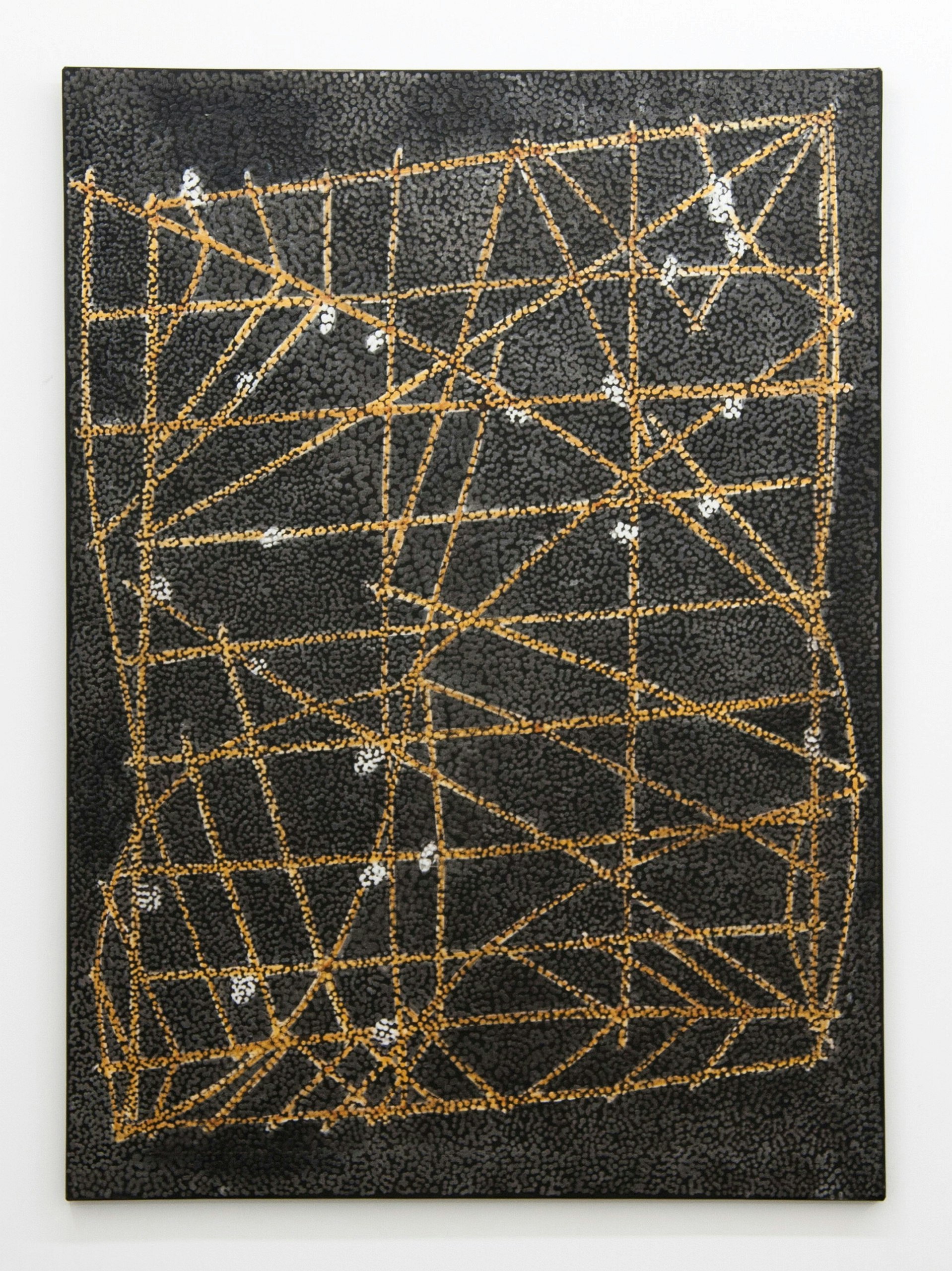‘Untitled’ 2012, ‘Untitled (TBD)’ 2015 and ‘Untitled (MINCC)’ 2014

Daniel Boyd Untitled (MINCC) 2014, private collection, Sydney © Daniel Boyd
Untitled 2012, Untitled (TBD) 2015 and Untitled (MINCC) 2014
Made from shells and wooden sticks bound together with coconut fibre, the linear structures that appear in these paintings are cartographic tools. These stick charts, or Rebbelib as they are known in Ṃajeḷ/Marshall Islands, map islands, currents and swells to navigate the Great Ocean (the Pacific).
Rebbelib are designed to connect fragmentary points across vast distances, drawing disparate people, objects and places together. In this sense, they operate in much the same way as Boyd’s lenses; pulled into compositional cohesion, these image fragments bridge the dark spaces between them.
Plain English version
This artwork is made of oil, charcoal and glue on canvas. It is privately owned in Sydney.
These paintings have lines made from shells and wooden sticks. Stick charts or ‘Rebbelib’ in Majel (Marshall Islands) show the islands, currents and swells in the Great Ocean (Pacific Ocean). They help map things out, connecting far away points and bringing together different people, objects and places.
The white dots on the Rebbelib work like Daniel Boyd's ‘lenses’. His images are connected across dark spaces.
Untitled (MINCC) is a rectangular painting in portrait orientation, measuring 2.56 x 1.62 metres, in oil, charcoal and archival glue on canvas. It was painted in 2014.
This work depicts a network of yellow lines, mostly straight, stretching across a dark background. This web makes a rectangle about a handspan narrower than the frame of the painting. Within the rectangle, lines divide the space into dozens of angular shapes of different dimensions – some as small as a fingernail, others leaving large gaps in an irregular lattice-like grid. Some lines run diagonally, creating triangles and diamond shapes over the darker background. A straight line runs down the centre of the web, framed by two slightly curved lines that meet at the vertex in a shape reminiscent of the point of a leaf. These three vertical lines create a balanced image and give a core strength to the central axis of the image.
Upon closer inspection, the surface of the painting is covered in thousands of tiny lenses. In the dark spaces, flecks of black charcoal and pale taupe contrast with a background layer of deep brown oil paint. The lattice is also made up of thousands of points of yellow. Some are a bright honey-gold, some are as pale as straw, and others are darker ochre, tinged with shades of brown richer and warmer than the background tones. Along some lines, the lenses cluster together, making a clear and defined belt of colour. At other points, the lenses are fainter and more dispersed. At certain places where these lines intersect, there are scattered circles of white spots.
The straight lines of the lattice are revealed to be a more complex mesh of individual marks, distinguished by their colour from a sea of similar lenses. Untitled (MINCC) depicts a Rebbelib, a cartographic tool made in Majel/the Marshall Islands to chart islands and ocean currents. The linear matrix, the circles of white lenses and the darker spaces between all map a real space, offering tens of thousands of pin-prick points of view of the Great Ocean.
This is the end of the audio description.
-
01
Audio description